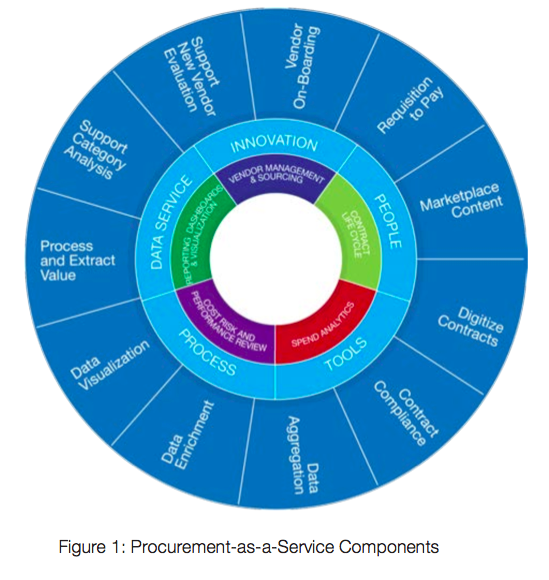What is Global Procurement as a Service?

Technology has been a critical driver for innovation in the last 20+ years, enabling more efficient workflows, cost-savings, strategic business advantages, and driving massive shareholder value.
But the adoption of technology in the procurement process has not driven the expected efficiencies it has in other areas. Enterprise procurement technology and corresponding procurement processes have become hopelessly complex due to the imbalance of control and speed.
Consequently, procurement has become a large component of total revenues. In their recent white paper, Procurement Transformation – Driving Performance & Results Beyond the Limits of Leverage, Everest Group said that on average, for a typical billion dollar organization, procurement represents 30-50% of total expenses incurred.
Multiple overlapping layers of approvals and complex workflows in the value stream have created a crisscross of work procedures. Communications problems, lack of transparency, and sub-optimal business processes have led to a misalignment of objectives, lack of innovation, and the creation of an onerous bureaucracy.
The haphazard adoption of procurement technology and lack of processes has actually exacerbated the problem that technology was supposed to solve. 
So what’s the solution? How can enterprise procurement leaders achieve these efficiencies?
Introducing Procurement as a Service
The most successful strategies are always the simplest and most straightforward. One viable scenario is to embrace the “as-a-service” mindset and treat the procurement function as a platform that streamlines the process through a combination of cloud-based technologies, processes and services. Such an approach could help to solve the procurement process dilemma by diminishing complexities and adopting simple and consistent processes.
And the time seems to be right for the as-a-service approach to reach wider adoption. A recent study by Procurement Leaders found that for 2015, 53% of Chief Procurement Officers surveyed planned to spend more on procurement technology, while an increasing number of organizations will adopt cloud solutions. The intelligent use of cloud-based technology solutions, coupled with defined processes that are based on proven best practices, can help make order out of chaos. Specifically, a good Procurement-as-a-Service solution entails:
- Technology to automate repetitive processes
- Analysis of spend to discover opportunities for improvement
- Innovative approaches to take advantage of opportunities uncovered during analysis
In Figure 1 we see a visual representation of the scope of a Procurement-as-a-Service platform.
The Components of Procurement-as-a-Service (global procurement services)
1. Vendor Management & E-Sourcing
Procurement-as-a-Service begins with the understanding of your current supply base through Vendor Management. Managing vendor information and keeping it current leads to smart sourcing, helping you reduce buy-to-pay transaction errors and maintain parent-child vendor relationships.

The next logical step is to drive productivity in the requisition-to-pay process, using E-sourcing tools. These are achieved through the use of online marketplaces for the acquisition of indirect material and services (buyer-less sourcing) to streamline indirect material sourcing. The effort is enhanced by easy-to-use taxonomy to drive spend rationalization. 3
Higher order spend analysis using a custom-built taxonomy helps segment suppliers into strategic, leveraged, critical and integrated vendors, allowing you to focus on the strategic and critical (single and sole sourced) suppliers to drive effective contracts.
2. Contract Lifecycle Management
With an advanced Contract Lifecycle Management application, you can use digital forms for various types of contracts to create boilerplates, while also simplifying the negotiation process by allowing virtual redline versions during negotiations.
Efficiency is gained by distributing responsibility at the clause level, so contracts can be reviewed by different functions. The use of electronic signatures and optimal workflows help make this a cost- effective solution, leading to easy process analysis and optimization.
3. Spend Analytics
Spend Analytics is accomplished by gathering data from disparate systems, and after performing data quality checks, custom business rules are written to help you review slices of data to drive decision-making.
It’s critical to understand spend categories, vendor segmentation, part analysis, pay term analysis, and to review spend under contract. Data science helps to manage contextual data to support decision-making, enabling quantum improvements in spend productivity.
4. Cost, Risk and Performance Review
Using data science technologies you can perform a Cost, Risk and Performance Review on your spend. Vendor risks are classified by the nature of risks—single or sole vendors, vendors in volatile geopolitical areas, and vendors impacted by market factors (commodity, foreign exchange and regulatory conditions). Vendor performance is classified by analyzing on-time delivery, and performance against client needs and promises made. Mandating data selectively during purchase order creation and processing helps in garnishing data for decision-making.
5. Reporting Dashboards and Visualization tools
Finally, equip your staff with Reporting Dashboards and Visualization Tools to identify opportunities for further procurement innovation.
Conclusion
Technology has been an efficiency enabler for corporations now for the last quarter of a century, helping companies make tremendous progress on the sales, marketing and marketing front. But till now the haphazard adoption of technology for the procurement process has only exacerbated a disjointed system fraught with inefficiencies.
Procurement as a Service solves this problem by combining cloud-based technology with intelligently managed processes to manage vendors, enable e-sourcing, manage the contract lifecycle, analyze and report on spend, and review cost, risks and performance; a global procurement strategy.
The combination of people, process and technology in a managed hosting environment is revolutionizing the procurement process, and is the next frontier in the business efficiency spectrum.
For a more in-depth look at Global Procurement as a Service, download our new white paper: Why Global Procurement as a Service si the Next Frontier in Business Efficiency.




